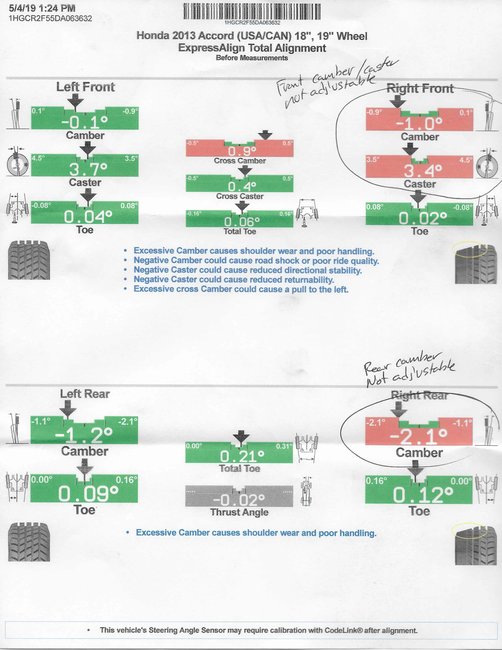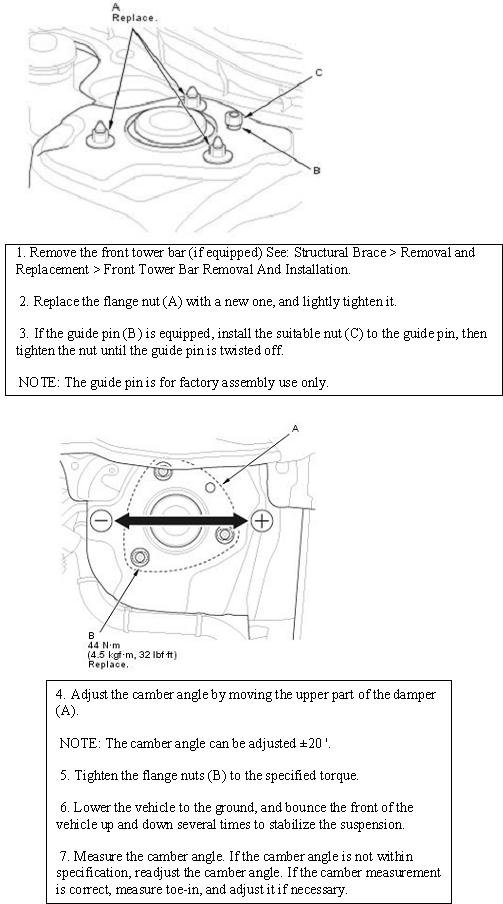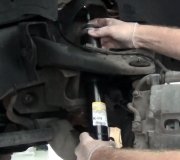Front camber can be adjusted, but it is a rather tedious procedure that most alignment specialists prefer to avoid. Also, it changes a lesser-known secondary alignment angle called "steering axis inclination", (SAI) on just that side. SAI has no exact specification except that it must be exactly the same on both sides to maintain balanced handling and steering. Many specialists don't want to upset that balance by making the adjustment the way Honda provided.
This is similar to Ford front-wheel-drive cars that do not have camber adjustments. That saves them a few dollars on each car when they build them. There are cheating ways to offset alignment pulls, but you'll still spend a lot of money replacing worn tires.
The place to start, if it wasn't already done, is to measure the car's suspension ride height. Every shop has a small book that lists every car model and year, where to take the measurements, and what they should be. If one side of the car sits too low, the coil springs must be replaced to restore ride height. That job is easier now with "quick struts" that include new coil springs and all the other hardware already included as a ready-to-install assembly. You pay more for parts but a lot less for labor. The important thing to remember about ride height is it affects the geometric changes the suspension parts go through as the car goes up and down as it bounces over bumps in the road, and as such, if that geometry is wrong, you will have miserable tire wear even if the numbers on the alignment computer are perfect. Those numbers only apply to a car that's standing still, on the hoist.
Camber is viewed as the wheel tipping in or out a little on top, as viewed from in front of the car. A tire wants to pull in the direction it is leaning, so along with not leaning too much, which adds to wear on the edges of the tread, both must be leaning the same amount to offset each other's pulls and make the car go straight when you let go of the steering wheel.
Thank you for posting the printout. It shows the front wheels call for negative camber, (leaning in on top). That is done for better cornering, at the expense of long tire life. The negative one tenth of a degree camber pull on the left will cause very little pull to the right, but the minus one degree on the right is going to make that tire pull pretty hard to the left. We also like to adjust in roughly one tenth of a degree pull to the left to make up for "road crown". That is when roads lean to the right so water runs off. It makes cars want to drift to the right too. The slight camber pull to the left offsets that drift. In this case the difference it too much and the car is going to pull to the left. The inner edge of the right front tire will wear out faster too.
Caster is a little more forgiving. That has to do with the angle of the strut, as viewed from the side of the car. Look at the rake of a bicycle fork, and how it leans to the rear at the top. When you put weight on the front tire, that angle causes the wheel to squirt out to the front and is what makes it so you can ride no-handed. On cars, caster makes both wheels want to turn very hard toward the center of the car. Connecting both wheels with the steering linkage causes them to offset each other, and the car goes straight. On older rear-wheel-drive cars, unequal caster also caused a pull, but about half as hard as a camber pull. The important thing to understand about front-wheel-drive cars is caster has almost no effect on pulling, so it is rarely adjustable from any manufacturer. Caster also has relatively little effect on tire wear. Caster causes the wheels to lean toward the direction you're turning, but that mostly applies to parking lots where you don't do much high-speed cornering. At highway speeds, we don't turn far enough for caster to influence tire wear.
Rear camber is not adjustable, so as with Fords, "what you got is what you get". Fixing sagged ride height might solve the camber issue, but could just as likely make it worse. The way to know is to watch the numbers on the alignment computer screen while that end if the car is raised and lowered a little to see what changes occur.
Rear toe is adjustable. That is the direction those wheels are steering. The problem is there are two wimpy control arms that hold the bottom of the wheel in place, and one of those is adjustable in length. Making that adjustment shortens or lengthens that arm to turn the wheel a little, but as it does that, it pushes the bottom in or out too, and that affects camber. The high negative right rear camber means the bottom of that wheel is out too far. The non-adjustable control arm needs to be shorter, and the adjustable one needs to be adjusted shorter to match. No two replacement suspension parts are ever exactly the same, so one replacement arm could make the problem worse.
We see these problems all the time, and for most of those, once the owner learns of the cost of trying to solve the alignment problems, they decide to just live with it and keep buying tires. You can try rotating them often to spread the wear out over all the tires, then buy four new ones at one time, or you can never rotate them, buy just two new tires for the front, and put the old front ones on the back. With less weight on the rear, those tires will wear slower than those on the front.
Image (Click to make bigger)
Monday, May 6th, 2019 AT 6:21 PM




